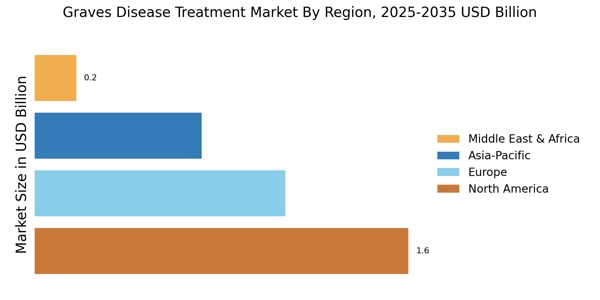Increased Awareness and Education
The rising awareness and education surrounding thyroid disorders, particularly Graves disease, are pivotal drivers for the Graves Disease Treatment Market. Public health campaigns and educational initiatives by healthcare organizations have significantly improved understanding of the disease, its symptoms, and available treatment options. This heightened awareness encourages individuals to seek timely medical intervention, which is crucial for effective management. As more patients become informed about their condition, the demand for various treatment modalities, including antithyroid drugs and surgical interventions, is likely to increase. Additionally, healthcare professionals are being trained to recognize and manage Graves disease more effectively, further contributing to market growth. The emphasis on education and awareness is expected to play a critical role in shaping the future of the Graves Disease Treatment Market.
Growing Prevalence of Graves Disease
The increasing incidence of Graves disease is a primary driver for the Graves Disease Treatment Market. Recent estimates indicate that the prevalence of hyperthyroidism, which includes Graves disease, affects approximately 1-2% of the population in various regions. This rising prevalence necessitates effective treatment options, thereby propelling market growth. As awareness of thyroid disorders expands, more individuals seek medical attention, leading to a higher demand for therapeutic interventions. The growing patient population is likely to stimulate the development of innovative treatment modalities, including antithyroid medications, radioactive iodine therapy, and surgical options. Consequently, healthcare providers are focusing on enhancing treatment protocols to address the needs of this expanding demographic, which is expected to further drive the Graves Disease Treatment Market.
Regulatory Support for New Treatments
Regulatory support for the development and approval of new treatments is a crucial driver for the Graves Disease Treatment Market. Regulatory agencies are increasingly recognizing the need for innovative therapies to address unmet medical needs in the management of Graves disease. This support includes expedited review processes and incentives for the development of novel pharmacological agents and treatment modalities. As a result, pharmaceutical companies are more inclined to invest in research and development, leading to a broader array of treatment options for patients. The introduction of new therapies not only enhances the treatment landscape but also stimulates competition within the market, potentially lowering costs and improving accessibility. Regulatory support is, therefore, a vital factor that is likely to shape the future trajectory of the Graves Disease Treatment Market.
Advancements in Treatment Technologies
Technological advancements in the treatment of Graves disease are significantly influencing the Graves Disease Treatment Market. Innovations such as minimally invasive surgical techniques and improved imaging technologies have enhanced the efficacy and safety of treatment options. For instance, the introduction of robotic-assisted surgeries has led to reduced recovery times and improved patient outcomes. Furthermore, the development of novel pharmacological agents, including targeted therapies, is reshaping the treatment landscape. These advancements not only improve the quality of care but also attract investment in research and development, thereby expanding the market. As healthcare providers adopt these cutting-edge technologies, the Graves Disease Treatment Market is poised for substantial growth, reflecting a shift towards more effective and patient-centered treatment approaches.
Rising Investment in Healthcare Infrastructure
The increasing investment in healthcare infrastructure is a significant driver for the Graves Disease Treatment Market. Governments and private entities are allocating substantial resources to enhance healthcare facilities, improve access to medical services, and support research initiatives. This investment is particularly evident in regions with a high burden of thyroid disorders, where healthcare systems are being strengthened to accommodate growing patient needs. Enhanced infrastructure facilitates better diagnosis and treatment options for Graves disease, leading to improved patient outcomes. Moreover, the establishment of specialized thyroid clinics and centers of excellence is likely to foster innovation in treatment approaches. As healthcare infrastructure continues to evolve, the Graves Disease Treatment Market is expected to benefit from improved service delivery and increased patient access to effective therapies.


















Leave a Comment